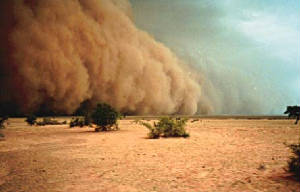|

Causes of Dust Storms
The best way to explain what a dust storm is is to describe
some of the causes of the dust storm. Essentially, a dust storm is caused by strong winds that travel over dry, arid
land with little vegetation and pick up tiny particles such as sand, dust, and other debris. Areas of land become susceptible
to erosion from high winds when the ground becomes bare. This can be caused by poor land management concerned either
with agriculture or overgrazing. The dust and debris carried by the wind form a large cloud or wall of dust that sweeps
across the landscape with the wind. This page will explain some of the meteorological mechanisms that cause these strong
winds, thereby creating a dust storm.
Dust storms can
be caused by many meteorological events which can be broken up into two categories, the first one being large scale, non-convective
events and the second is convective events. A meteorological event can be classified into one of these two categories
by the type of weather phenomena associated with the event, the predictability of the event, the duration of the event, and
when the event occurs.
Large scale, non-convective
events are often characterized by sustained high winds at the surface that are often associated with wind storms. Dust
storms resulting from and event in this category can be predicted anywhere from 24 to 36 hours ahead of time due to the easy
identification of the recognizable weather patterns that often occur with this type of event. These dust storms can
last from 3 to 4 hours, or up to 2 to 3 days depending on the situation. Dust storms of this type often occur in the
late winter to early spring when there is an extreme pressure gradient. They often worsen in the late morning and are
more intense in the late afternoon. In the case of a dust storm that lasts more than a day, the intensity has a tendency
to weaken through the night.
A convective event would
be something like a thunderstorm outflow or a micro burst. They are far less predictable than the large scale non-convective
events. Over the area of jurisdiction, dust storms caused by convective events are predictable up to three hours ahead
of time. However, for a specific location, they are only identifiable minutes before they hit. The duration of
these dust storms varies with the mechanism that causes them. A dust storm caused by a micro burst may last only a few
seconds, while one caused by a macro burst can last a few minutes, and a dust storm caused by a wake depression can last for
hours. The phenomena that are classified as convective events occur during the late afternoon in the spring and summer.

Source: Lubbock Texas Dust Storm
Large scale, non-convective events,, such as the passage of
fronts and troughs or the down mixing of upper level winds are responsible for 2/3 of dust events. The Lubbock, Texas
dust storm pictured above is an example of a dust storm cause by one of these large scale, non-convective events. Convective
events are responsible for less dust storms, but the ones they are responsible for are the most dramatic clouds with the lowest
visibility's. The Big Springs, Texas dust storm pictured below is an example of a dust storm caused by a convective
event.
.JPG)
Source: Big Springs, TX Dust Storm
In conclusion, Dust storms can be caused by a number of different
meteorological mechanisms that can be defined as either a large scale, non-convective event, or as a convective event.
There are noticeable differences between the two such as duration, predictability, time frame in which they occur, and the
weather phenomena that are associated with the dust storm that can help to identify what type of an event it is. These
are the causes of dust storms. |
|

